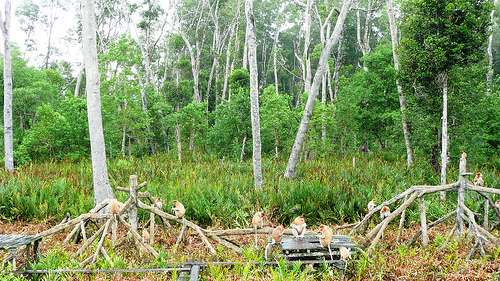To understand the global impact of deforestation, we must first understand the basic biology of the rainforest and the causes of deforestation.
Rainforests cover less than 7 percent of the globe. They are predominantly found in a wet or moist band circling the globe along the equator. Tropical rainforests are some of the richest, oldest, most productive and genetically diverse ecosystems in the world. Between 40 and 50 percent of all living organisms (plants and animals) on this planet live in the rainforest.
What characterizes a rainforest? Temperature and rainfall. The equatorial rainforests, which represent about two-thirds of the world’s rainforests, receive more than 250 inches of rain per year. The average temperature is 80 degrees Fahrenheit, with no seasonal fluctuation in temperature during the year.
The second main group of tropical rainforests receives less rainfall–40-160 inches per year–and has distinct wet and dry seasons. These seasonal rainforests are not as genetically diverse as the equatorial rainforests.
In years past, the rainforests covered over 14 percent of the earth’s surface. Now they cover less than half of this. Most of the destruction has resulted from human intervention in the last 200 years, and more specifically since 1950. Of the remaining rainforests, almost 60 percent are located in Latin America.
Most people in developed countries are so far removed from nature they are unable or unwilling to perceive the relevance or relationship of rainforest organisms to their daily life. They do not know that many products they use come directly or indirectly from tropical rainforests. Some of the more common products are rubber, teak, mahogany, pesticides, medicinally useful drugs and many active anti-cancer compounds. Some food items include cashew nuts, avocado, mango, cocoa, coffee, and spices like vanilla and nutmeg.
We know that 25 percent of all prescription drugs marketed in the United States contain one or more rainforest plant compounds. We can assume that many new drugs are awaiting discovery in the rainforest, yet fewer than one percent of tropical species have been examined for their possible use by mankind.
As deforestation continues, millions of yet undocumented and documented species of plants and animals go extinct. There are literally thousands, if not millions, of yet-to-be discovered species that could one day yield vital or economically valuable products.
“Deforestation” means the removal of large tracts of tropical forest for agricultural, urban, or industrial use. A “primary” or “virgin” forest is one that has been undisturbed for centuries. If it has not been disturbed, it is often called a “climax forest,” which means it is no longer going through stages of development. Once primary forests are disturbed in any manner, they are no longer in equilibrium, and are now classified as “secondary forests.” Human intervention is usually the cause.
Forest conservation implies that our use of the forest comes with a degree of preservation, and wise use of the forest involves trade-offs between preservation and development. The “gene pool” and “genetic diversity” refer to the quantity and variety of the individual organisms, populations, or species in the forest.
Tropical rainforests serve as a source of genetic material. It can, and currently does, provide products of economic and medicinal importance to people in both developing and developed countries. One example of why a gene bank is crucial can be seen in the Corn Blight of 1968. In the summer of that year, some farmers noticed a mysterious disease on their corn plants. This was the first sign of a very dangerous fungus that reproduced rapidly in the warm moist weather of 1970. Under these conditions, the disease spread across the Southeast, toward the United States’ corn belt and proceeded to leave the cornfields in shambles.
This fungus, later called “The Southern Corn Leaf Blight,” spread in four months from Georgia to Oklahoma. It spread so quickly because the United States corn crop was genetically uniform, so what affected one plant affected them all. For this reason, a diverse gene pool is very important.
Rainforests are being destroyed or severely degraded every minute of the day, every day of the week and every week of the year. The United States National Academy of Sciences reports that we lose an area the size of England, Scotland and Wales (50 million acres) each year. At this rate, we will lose all of the world’s remaining rainforests by the year 2050, just forty years from now, and in turn, we will lose access to that genetic material forever.

